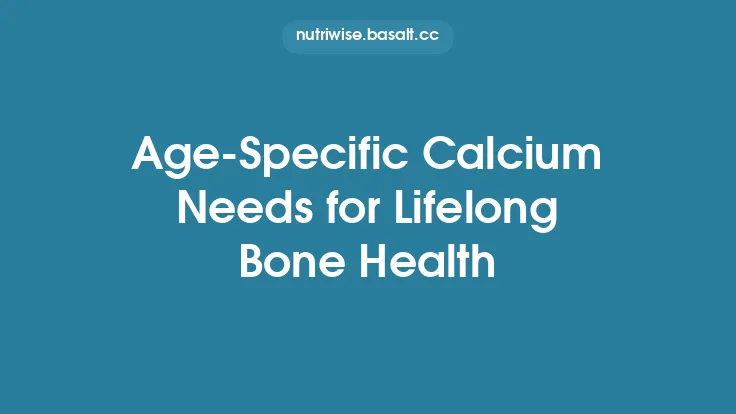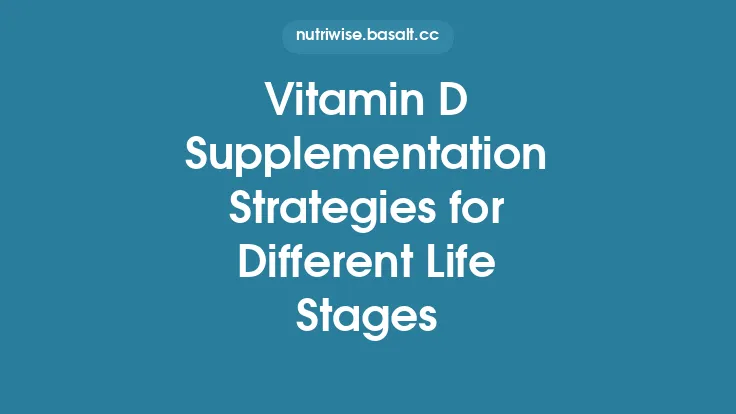Calcium and vitamin D are the two most frequently cited nutrients when discussing bone health, yet their relationship is far more intricate than simply “more calcium + more vitamin D = stronger bones.” The body’s ability to maintain a robust skeletal framework hinges on a tightly regulated system in which calcium provides the structural material while vitamin D orchestrates its proper handling, distribution, and incorporation. Understanding how these micronutrients interact, the physiological pathways that link them, and the practical steps you can take to keep them in balance is essential for anyone seeking long‑term bone maintenance.
The Physiological Dance: How Vitamin‚ÄØD Governs Calcium Homeostasis
At the heart of bone maintenance lies a feedback loop that involves the intestine, kidneys, and bone tissue. Vitamin‚ÄØD, in its active form calcitriol (1,25‚Äëdihydroxyvitamin‚ÄØD), is the master regulator of this loop.
- Synthesis and Activation
- Skin production: Ultraviolet‚ÄëB (UV‚ÄëB) photons convert 7‚Äëdehydrocholesterol in the epidermis to pre‚Äëvitamin‚ÄØD‚ÇÉ, which spontaneously isomerizes to vitamin‚ÄØD‚ÇÉ (cholecalciferol).
- Hepatic conversion: Vitamin‚ÄØD‚ÇÉ is hydroxylated by the enzyme CYP2R1 to 25‚Äëhydroxyvitamin‚ÄØD (25(OH)D), the primary circulating form used to assess status.
- Renal activation: 25(OH)D is further hydroxylated by 1α‑hydroxylase (CYP27B1) in the proximal tubule to produce calcitriol. This step is tightly controlled by parathyroid hormone (PTH), serum calcium, and phosphate levels.
- Intestinal Calcium Absorption
Calcitriol binds to the vitamin‚ÄØD receptor (VDR) in enterocytes, up‚Äëregulating transcription of calcium‚Äëtransport proteins such as TRPV6 (transient receptor potential vanilloid type 6) and calbindin‚ÄëD‚Çâk. These proteins facilitate active, transcellular calcium transport, especially when dietary calcium is modest. In the presence of adequate vitamin‚ÄØD, the efficiency of calcium absorption can rise from ~10‚ÄØ% to >30‚ÄØ% of ingested calcium.
- Renal Calcium Reabsorption
Calcitriol also enhances calcium reabsorption in the distal nephron, reducing urinary calcium loss. This effect works synergistically with PTH, which stimulates the expression of calcium channels (e.g., TRPV5) in renal tubular cells.
- Bone Remodeling
Within bone, calcitriol exerts a dual influence: it promotes osteoblast differentiation (cells that lay down new bone matrix) and, under certain conditions, stimulates osteoclastogenesis indirectly via the RANKL‚ÄëOPG pathway. The net effect is a balanced remodeling process that replaces old bone with new, mineralized tissue.
Because vitamin‚ÄØD sits at the nexus of these three organ systems, any deficiency or excess can dramatically shift calcium balance, leading to either bone demineralization or pathological calcification.
Defining the “Goldilocks” Zone: Recommended Intakes and Serum Targets
| Nutrient | Recommended Dietary Allowance (RDA)* | Upper Intake Level (UL) | Desired Serum Concentration |
|---|---|---|---|
| Calcium | 1,000 mg (adults 19‑50 yr) <br>1,200 mg (≥ 51 yr) | 2,500 mg (19‑50 yr) <br>2,000 mg (≥ 51 yr) | — |
| Vitamin D (D₃) | 600 IU (15 µg) (19‑70 yr) <br>800 IU (20 µg) (≥ 71 yr) | 4,000 IU (100 µg) | 25‑hydroxyvitamin D ≥ 30 ng/mL (≥ 75 nmol/L) |
\*Values reflect the Institute of Medicine (now the National Academy of Medicine) guidelines for generally healthy adults. Adjustments may be needed for individuals with specific medical conditions, limited sun exposure, or malabsorption syndromes.
Why the ratio matters:
While the RDA for calcium is expressed in milligrams, vitamin D is measured in International Units (IU) or micrograms. The functional relationship is not a simple weight‑to‑weight ratio but rather a stoichiometric one: each molecule of calcitriol can up‑regulate multiple calcium‑transport proteins, amplifying calcium’s bioavailability. Empirical studies suggest that maintaining serum 25(OH)D levels above 30 ng/mL ensures that the intestine can absorb at least 30 % of dietary calcium, a threshold often cited as sufficient for bone maintenance in the absence of other limiting factors.
Timing and Co‚ÄëAdministration: Maximizing Synergy
- Concurrent Ingestion
- Rationale: Vitamin D’s effect on calcium absorption is most pronounced when both nutrients are present in the gastrointestinal lumen. The presence of dietary fat (required for vitamin D absorption) also aids calcium solubilization.
- Practical tip: Take calcium supplements (or calcium‑rich meals) together with a vitamin D source—whether a fortified food, a modest dose of a supplement, or a brief period of sun exposure earlier in the day.
- Meal Composition
- Fat content: Vitamin‚ÄØD is fat‚Äësoluble; a meal containing 5‚Äë10‚ÄØg of healthy fat (e.g., olive oil, avocado, nuts) improves its absorption.
- Avoiding antagonists: While the focus here is not on other absorption inhibitors, it is worth noting that very high doses of certain minerals (e.g., zinc) can compete for transport pathways. Keeping calcium and vitamin‚ÄØD intake within recommended ranges minimizes such competition.
- Chronobiology
- Morning sun exposure: UV‚ÄëB intensity peaks between 10‚ÄØa.m. and 2‚ÄØp.m. A 10‚Äë15‚ÄØminute exposure of face, arms, and hands during this window can generate 1,000‚Äë2,000‚ÄØIU of vitamin‚ÄØD, depending on skin type and latitude.
- Evening calcium intake: Some evidence suggests that calcium taken before bedtime may support nocturnal bone remodeling, a period when PTH levels naturally rise. Pairing this with a small dose of vitamin‚ÄØD can sustain the absorption machinery throughout the night.
Assessing Status: From Blood Tests to Bone Health Indicators
- Serum 25‚ÄëHydroxyvitamin‚ÄØD
- The gold‚Äëstandard marker for vitamin‚ÄØD status. Levels <‚ÄØ20‚ÄØng/mL indicate deficiency; 20‚Äë30‚ÄØng/mL suggest insufficiency; >‚ÄØ30‚ÄØng/mL are considered sufficient for bone health.
- Seasonal fluctuations are common; re‚Äëtesting in late winter or early spring provides a realistic baseline for many individuals.
- Serum Calcium and PTH
- Total calcium is tightly regulated; a normal serum calcium with elevated PTH (secondary hyperparathyroidism) often signals inadequate vitamin‚ÄØD or calcium availability at the tissue level.
- Measuring intact PTH alongside 25(OH)D can help differentiate between dietary insufficiency and renal conversion problems.
- Bone Turnover Markers
- Bone‚Äëspecific alkaline phosphatase (BSAP) and C‚Äëtelopeptide (CTX) reflect formation and resorption, respectively. While not routinely required, they can be useful in research or in monitoring high‚Äërisk patients undergoing therapeutic adjustments.
- Dual‚Äëenergy X‚Äëray Absorptiometry (DXA)
- The definitive tool for assessing bone mineral density (BMD). Changes in BMD over time can validate whether calcium‚Äëvitamin‚ÄØD strategies are translating into structural benefits.
Tailoring the Balance for Special Situations
| Situation | Vitamin‚ÄØD Considerations | Calcium Considerations | Practical Adjustments |
|---|---|---|---|
| Limited Sun Exposure (e.g., high latitudes, indoor occupations) | Higher supplemental doses (1,000‚Äë2,000‚ÄØIU/day) often needed to achieve serum ‚â•‚ÄØ30‚ÄØng/mL. | Maintain RDA; monitor for hypercalcemia if high‚Äëdose vitamin‚ÄØD is used. | Use fortified dairy or plant milks; schedule brief outdoor walks when UV‚ÄëB is available. |
| Malabsorption Syndromes (celiac disease, Crohn’s disease) | Oral vitamin D may require higher doses or water‑soluble formulations. | Calcium citrate (vs. carbonate) is better absorbed without gastric acid. | Split calcium doses throughout the day; consider monitored supplementation under medical guidance. |
| Renal Impairment | Reduced 1α‑hydroxylase activity limits conversion to calcitriol; active vitamin D analogs (e.g., calcitriol) may be prescribed. | Calcium intake may need to be moderated to avoid vascular calcification. | Close laboratory monitoring (serum calcium, phosphorus, PTH) and individualized dosing. |
| Obesity | Sequestration of vitamin‚ÄØD in adipose tissue lowers bioavailability; higher supplemental doses often required. | Calcium absorption is not impaired, but dietary patterns may be suboptimal. | Aim for 1,500‚Äë2,000‚ÄØIU vitamin‚ÄØD daily; ensure calcium sources are part of balanced meals. |
Emerging Insights: Beyond the Classic Pathway
- Vitamin‚ÄØD Receptor Polymorphisms
- Genetic variations in the VDR gene can affect the receptor’s affinity for calcitriol, influencing calcium absorption efficiency. While routine testing is not yet standard, research suggests that individuals with certain polymorphisms may benefit from slightly higher vitamin D intakes.
- Synergy with Vitamin‚ÄØK‚ÇÇ
- Vitamin‚ÄØK‚ÇÇ (menaquinone) directs calcium to the bone matrix and away from soft tissues. Although the primary focus here is calcium‚Äëvitamin‚ÄØD balance, emerging data indicate that adequate vitamin‚ÄØK‚ÇÇ may enhance the bone‚Äëbuilding effects of the calcium‚Äëvitamin‚ÄØD duo, especially in older adults.
- Non‚ÄëCalcemic Vitamin‚ÄØD Metabolites
- Metabolites such as 24,25‚Äëdihydroxyvitamin‚ÄØD have been implicated in bone remodeling independent of calcium transport. Their clinical relevance is still under investigation, but they represent a frontier for future supplementation strategies.
- Chronotherapy
- Timing of vitamin‚ÄØD supplementation relative to circadian rhythms may affect its conversion to the active form. Preliminary trials suggest that morning dosing aligns better with endogenous cortisol peaks, potentially optimizing calcium handling.
Putting It All Together: A Practical Blueprint
- Assess Baseline Status
- Obtain a serum 25(OH)D measurement. If <‚ÄØ30‚ÄØng/mL, plan a modest loading phase (e.g., 2,000‚ÄØIU daily for 8‚ÄØweeks) followed by a maintenance dose tailored to sun exposure and diet.
- Secure Adequate Calcium
- Aim for the RDA through a combination of foods (dairy, fortified products, fish with bones) and, if needed, a calcium citrate supplement split into two doses (e.g., 500‚ÄØmg each with meals).
- Synchronize Intake
- Pair each calcium dose with a source of vitamin‚ÄØD: a fortified breakfast cereal, a small supplement, or a brief sun exposure session earlier that day.
- Monitor Periodically
- Re‚Äëcheck serum 25(OH)D after 3‚Äë4‚ÄØmonths of supplementation. Adjust vitamin‚ÄØD dose to maintain ‚â•‚ÄØ30‚ÄØng/mL. If calcium intake is high (>‚ÄØ1,500‚ÄØmg) and serum calcium rises, consider reducing calcium or evaluating for hyperparathyroidism.
- Lifestyle Integration
- Incorporate weight‚Äëbearing activities (e.g., brisk walking, resistance training) to stimulate bone formation. While this falls outside the strict calcium‚Äëvitamin‚ÄØD discussion, it complements the biochemical balance.
- Stay Informed
- Keep abreast of new guidelines, especially regarding vitamin‚ÄØD analogs for specific medical conditions, and consider genetic testing if you have a family history of osteoporosis despite optimal nutrient intake.
Bottom Line
Optimal bone maintenance is not achieved by treating calcium and vitamin D as isolated nutrients. Their interdependence—vitamin D’s orchestration of calcium absorption, renal reabsorption, and skeletal deposition—means that a balanced, well‑timed intake of both is essential. By ensuring sufficient vitamin D status (through sensible sun exposure, diet, or supplementation), meeting calcium needs within recommended limits, and aligning their consumption to maximize physiological synergy, you create a robust internal environment that supports continuous bone remodeling and long‑term skeletal health. Regular monitoring and individualized adjustments keep the system in the “just right” zone, allowing you to maintain strong, resilient bones throughout life.





